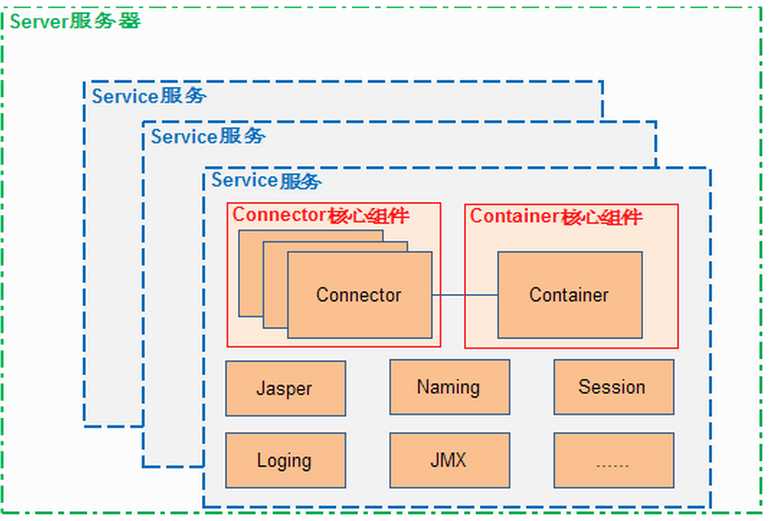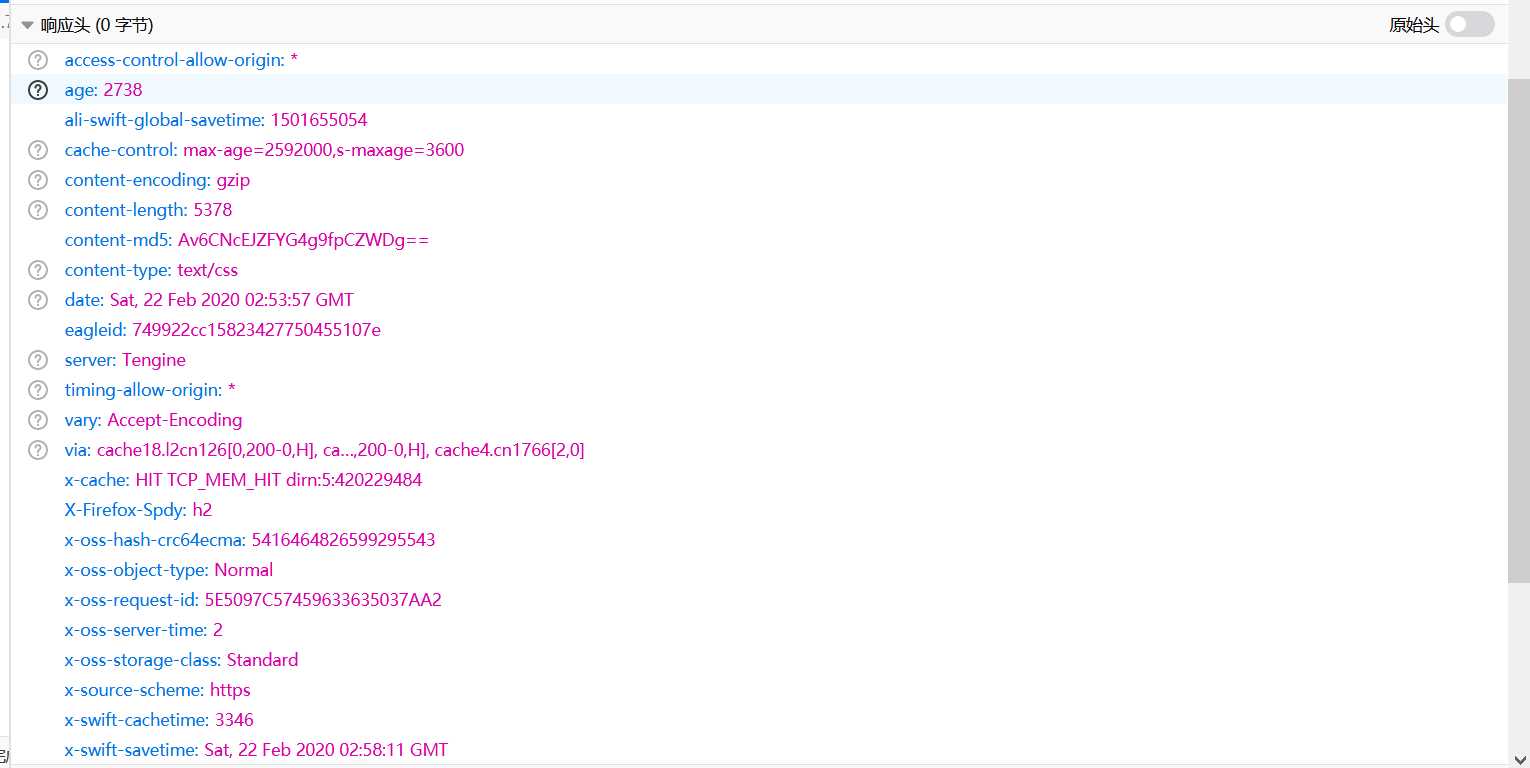标签:pac exception 一个 关闭 Map集合 ade http请求 rgs 输入流
大学已经过了一年半了,从接触各种web服务器软件已经有一年多了,从大一上最开始折腾Windows电脑自带的IIS开始,上手了自己的第一个静态网站,从此开启了web方向学习的兴趣。到现在,从陪伴了javaweb阶段的Tomcat走来,也陆续接触了jetty,Nginx等web服务器软件。但是,这些web服务器的软件也一直都是开箱即用,从未探究过其背后的原理。今天,尽量用最简单的java代码,实现一个最简陋的web服务器软件,揭开web服务器软件的神秘面纱。

由上图可以看出,Tomcat作为如今相对成熟的web服务器软件,有着相对较为复杂的架构,有着Server、Service、Engine、Connerctor、Host、Context等诸多组件。对于Tomcat的源码分析将在以后的博文中分篇讲解
,在此不在叙述。本节主要是实现一个自己的web服务器软件,其架构也超级简单。
public class ServerThread implements Runnable {
@Override
public void run() {}
}浏览器发送Http请求时,需要有一个Socket来接受,并且需要或等输入、输出流。
private Socket client;
private InputStream in;
private OutputStream out;在Tomcat中,有一个webapp文件夹用来存放静态资源,在此,我们也在D盘根路径下定义一个webroot文件夹,用来存储静态的资源。(该路径也可以通过获取当前j软件的相对路径来动态生成,但是为了简单起见,更好的揭示web服务器的工作流程,在此采用的是绝对路径)
private static final String WEBROOT = "D:\\webroot\\"; /**
* 构造函数初始化客户端
*/
public ServerThread(Socket client) {
this.client = client;
//其他初始化信息
try {
//获取客户端连接的流对象
in = client.getInputStream();
out = client.getOutputStream();
} catch (IOException e) {
e.printStackTrace();
}
}该构造函数相当的简单,就是获取浏览器发来的Socket,并拿到其中的输入、输出流,然后赋值给全局变量。
//读取请求的内容
reader = new BufferedReader(new InputStreamReader(in));解析获取的内容,并且放回网站得首页(index.html)
//取得:后面得内容
String line = reader.readLine().split(" ")[1].replace("/","\\");
if("\\".equals(line)) {
line += "index.html";
}
System.out.println(line);
//获取文件的后缀名
String strType = line.substring(line.lastIndexOf(".")+1, line.length());
System.out.println("strType = " + strType);给浏览器进行响应(用浏览器打开任意一个网站,调出控制台观查其响应头,因此我们的web服务器也应该把响应头给浏览器写出)

所以我们的代码应该为:
//给用户响应
pw = new PrintWriter(out);
input = new FileInputStream(WEBROOT + line);
//BufferedReader buffer = new BufferedReader(new InputStreamReader(input));
//写响应头
pw.println("HTTP/1.1 200 ok");
pw.println("Content-Type: "+ contentMap.get(strType) +";charset=utf-8");
pw.println("Content-Length: " + input.available());
pw.println("Server: hello");
pw.println("Date: " + new Date());
pw.println();
pw.flush();因为放返回数据的类型有多样,所以我们可以用一个map集合来存储,并在类加载前将数据存入。
/**
* 静态资源的集合(对应的文本类型)
*/
private static Map<String,String> contentMap = new HashMap<>();
//初始化静态资源的集合
static {
contentMap.put("html", "text/html");
contentMap.put("htm", "text/html");
contentMap.put("jpg", "image/jpeg");
contentMap.put("jpeg", "image/jpeg");
contentMap.put("gif", "image/gif");
contentMap.put("js", "application/javascript");
contentMap.put("css", "text/css");
contentMap.put("json", "application/json");
contentMap.put("mp3", "audio/mpeg");
contentMap.put("mp4", "video/mp4");
} //向浏览器写数据
byte[] bytes = new byte[1024];
int len = 0;
while ((len = input.read(bytes)) != -1){
out.write(bytes, 0, len);
}
pw.flush(); if(input != null) {
input.close();
}
if(pw != null) {
pw.close();
}
if(reader != null) {
reader.close();
}
if(out != null) {
out.close();
}
if(client != null) {
client.close();
}package com.xgp.company;
import java.io.*;
import java.net.Socket;
import java.util.Date;
import java.util.HashMap;
import java.util.Map;
import java.util.concurrent.ConcurrentHashMap;
/**
* 服务线程
* @author 薛国鹏
*/
public class ServerThread implements Runnable {
/**
* 静态资源的集合(对应的文本类型)
*/
private static Map<String,String> contentMap = new HashMap<>();
//初始化静态资源的集合
static {
contentMap.put("html", "text/html");
contentMap.put("htm", "text/html");
contentMap.put("jpg", "image/jpeg");
contentMap.put("jpeg", "image/jpeg");
contentMap.put("gif", "image/gif");
contentMap.put("js", "application/javascript");
contentMap.put("css", "text/css");
contentMap.put("json", "application/json");
contentMap.put("mp3", "audio/mpeg");
contentMap.put("mp4", "video/mp4");
}
private Socket client;
private InputStream in;
private OutputStream out;
private static final String WEBROOT = "D:\\webroot\\";
/**
* 构造函数初始化客户端
*/
public ServerThread(Socket client) {
this.client = client;
//其他初始化信息
try {
//获取客户端连接的流对象
in = client.getInputStream();
out = client.getOutputStream();
} catch (IOException e) {
e.printStackTrace();
}
}
/**
* 解析信息,给用户响应
*/
@Override
public void run() {
PrintWriter pw = null;
BufferedReader reader = null;
FileInputStream input = null;
try {
//读取请求的内容
reader = new BufferedReader(new InputStreamReader(in));
/**
* //请求的资源
* //解析请求头
* Host: static.zhihu.com
* User-Agent: Mozilla/5.0 (Windows NT 10.0; Win64; x64; rv:73.0) Gecko/20100101 Firefox/73.0
* Accept: text/css,
*/
//取得:后面得内容
String line = reader.readLine().split(" ")[1].replace("/","\\");
if("\\".equals(line)) {
line += "index.html";
}
System.out.println(line);
//获取文件的后缀名
String strType = line.substring(line.lastIndexOf(".")+1, line.length());
System.out.println("strType = " + strType);
//给用户响应
pw = new PrintWriter(out);
input = new FileInputStream(WEBROOT + line);
//BufferedReader buffer = new BufferedReader(new InputStreamReader(input));
//写响应头
pw.println("HTTP/1.1 200 ok");
pw.println("Content-Type: "+ contentMap.get(strType) +";charset=utf-8");
pw.println("Content-Length: " + input.available());
pw.println("Server: hello");
pw.println("Date: " + new Date());
pw.println();
pw.flush();
//向浏览器写数据
byte[] bytes = new byte[1024];
int len = 0;
while ((len = input.read(bytes)) != -1){
out.write(bytes, 0, len);
}
pw.flush();
}catch (Exception e) {
throw new RuntimeException(e.getMessage() + "服务端的run方法出错");
}finally {
try {
if(input != null) {
input.close();
}
if(pw != null) {
pw.close();
}
if(reader != null) {
reader.close();
}
if(out != null) {
out.close();
}
if(client != null) {
client.close();
}
} catch (IOException e) {
e.printStackTrace();
}
}
}
}
//创建一个可伸缩的连接池
pool = Executors.newCachedThreadPool(); //启动服务器,监听8080端口
server = new ServerSocket(80);
System.out.println("服务器启动,当前端口为80");while (!Thread.interrupted()){
//不停接收客户端请求
Socket client = server.accept();
//向线程池中提交任务
pool.execute(new ServerThread(client));
}if(server != null) {
server.close();
}
if(pool != null) {
pool.shutdown();
}package com.xgp.company;
import java.io.IOException;
import java.net.ServerSocket;
import java.net.Socket;
import java.util.concurrent.ExecutorService;
import java.util.concurrent.Executors;
/**
* 服务端
* @author 薛国鹏
*/
public class MyHttpServer {
public static void main(String[] args) {
ServerSocket server = null;
ExecutorService pool = null;
try {
//创建一个可伸缩的连接池
pool = Executors.newCachedThreadPool();
//启动服务器,监听8080端口
server = new ServerSocket(80);
System.out.println("服务器启动,当前端口为80");
while (!Thread.interrupted()){
//不停接收客户端请求
Socket client = server.accept();
//向线程池中提交任务
pool.execute(new ServerThread(client));
}
}catch (Exception e) {
throw new RuntimeException(e.getMessage() + "服务端异常");
}finally {
try {
if(server != null) {
server.close();
}
if(pool != null) {
pool.shutdown();
}
} catch (IOException e) {
e.printStackTrace();
}
}
}
}

调出浏览器控制台,看请求的资源是否正常解析:

可以看到,页面正确渲染了,请求的资源也没有发生问题,因此我们自己编写的简陋版本的web服务器软件编写成功。
标签:pac exception 一个 关闭 Map集合 ade http请求 rgs 输入流
原文地址:https://www.cnblogs.com/xgp123/p/12345028.html